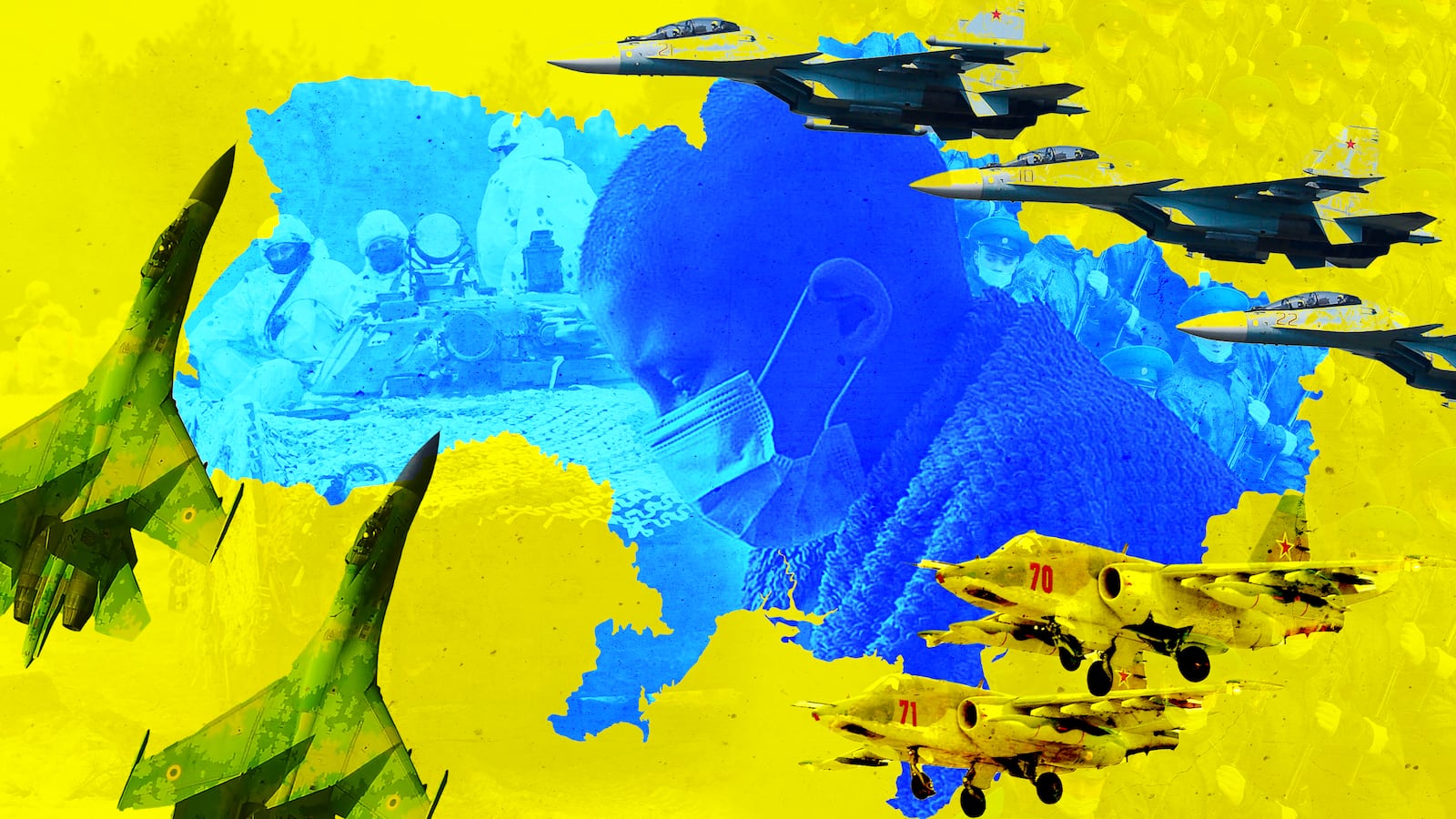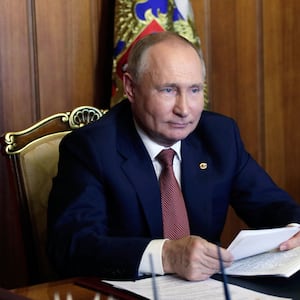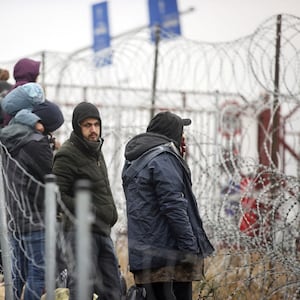CHERNIHIV, Ukraine—For years, Ukraine has been dealing with Russian aggression and preparing for an invasion on its Eastern flank where the two nations share more than 1,000 miles of sometimes disputed borders. But the recent bromance between President Vladimir Putin and his Belarusian counterpart has opened up the terrifying possibility of a new line of attack.
The southern border of Belarus is less than a three-hour drive from Kyiv, Ukraine’s economic and political capital.
Belarusian President Alexander Lukashenko has always had a testy relationship with Putin, until Moscow rescued him from an attempted popular revolution last year. By way of repayment, Lukashenko has signed up for the closest integration between the two countries since the collapse of the Soviet Union.
Ukraine already believes the hackers behind a massive cyberattack launched this month were linked to Belarus intelligence acting on behalf of Moscow. The cooperation got even closer on Wednesday when Russian troops landed in Belarus to hold joint anti-Ukraine military exercises close to the southern border.
Kyiv is now effectively surrounded by hostile forces.
Perhaps the most obvious route into Ukraine from the north is through Chernihiv, 40 miles from the border, a spectacular city which has played a pivotal role in previous conflicts. It was seized by the Nazis in September 1941 as Hitler ordered the Wehrmacht to push east. The Red Army won it back in a brutal battle two years later. “More than 70 percent of our city’s architecture was destroyed during the battles of World War II,” Stanislav Ivaschenko explained to The Daily Beast as we toured the stunning architectural remnants of a city that was founded in the ninth century and now has a population of 285,000.
The current inhabitants fear they are once more on the cusp of history.
“Russian tanks can be here in less than an hour,” said Serhii Zasimenko, the manager of a children’s cancer ward in the city. “The news means one thing: We have to be prepared for the war and evacuate kids with cancer from our clinic.”
Zasimenko, 37, is also a volunteer in the Territorial Defense Force, which trains civilians to support the army if the country comes under attack. The unit in Chernihiv counts about 4,000 local volunteers, who had their last round of military training a few months ago.
Right now, his main concern is how to evacuate 29 children with cancer from the hematology department of the Chernihiv regional hospital, “in case Putin attacks.” He can’t bear to raise the question with the parents of the sick children. “They have a war of their own,” he said.
Of course, most of the children are oblivious to the news buzzing through Ukraine. On Tuesday, there were reports of Canada deploying special forces to defend Ukraine, Britain sending over anti-tank weapons, and U.S. Secretary of State Antony Blinken flying into Kyiv for last-ditch talks.
In the ward, 4-year-old Varia Tishenko, who has a diagnosis of acute lymphoblastic leukemia, was riding a new three-wheel bike along the hospital’s hallway, waving her hand at the adults. Like all the kids receiving chemo in the department, Tishenko was bald under her little cap. Her face was covered with a mask but you could tell from her eyes that she was smiling.
The tricycle was a gift from the “We Fulfill Dreams” program. Another patient, Nika Pushenko, 16, asked for a ring. Her dream is to have a wedding one day.
Zasimenko feels a responsibility to keep that hope alive.
With his dog Monia by his side, he points at a map of the region, going over his thinking: “Plan A would be to move the kids to the hematological hospital in Kyiv, but in case our army blows up the bridges across Desna, we’d have to drive around in the direction of Kanev,” he told The Daily Beast. “We have the sterile transport needed for our little patients, but if there are no bridges left, we’d ask Kyiv volunteers to bring rafts, so we could cross the river.”
Zasimenko was 29 when the war began in Donbas. He traveled east as a volunteer, losing a good friend to a mine explosion in October 2014. The war has mellowed him. “Neither me, nor little Varya can influence Putin's geopolitical decision; but I hope that we manage to save the future, so the dreams of the children at our hospital come true.”
One thing Ukrainian civilians have learned in almost eight years of ongoing conflict with Russia-backed forces is how to organize volunteer communities. Ordinary civilians have been taking on extraordinary responsibilities since the very beginning.
Olga Palkova-Svirchevska, a bank manager, saw a huge military plane land at the abandoned Soviet airport outside of her apartment block in March 2014. Russians descended the steps onto a runway that was overgrown with grass.
“On that day I became a military volunteer. My friends and I raised money and brought everything our soldiers asked for. We threw bags with food or medicine over the fences around the military bases; we have land troops, pilots based in Chernihiv—we even helped submariners who had been transferred to Chernihiv from the occupied Crimea,” she told The Daily Beast.
The once sleepy region has changed rapidly since then. The city’s own airport is now full of life, with an aviation and pilot school up and running. “Now we hear sounds of small and big planes landing all the time. Thanks to Putin, we have a professional experienced army, police, and border service. There are anti-tank trenches along our border, which we did not have before the war.”
The people are steeled for more action. “We lived for decades without knowing where the border was between Belarus and Ukraine,” she said. “But since 2014 we have no doubt that the border is a war zone that can blow up at any moment.”
Belarusian leader Lukashenko, who’s been in power since 1994, claimed on Monday that it was Ukraine that was becoming belligerent, accusing it of continuing “to build National Guard forces out of nationalist radicals, which is even worse than NATO military and that is all very close to our state border.”
Many here fear Moscow could justify an attack on the country by fabricating news about aggression on the Belarusian border. “Lukashenko is using Putin’s propaganda [to] claim that there is a fascist regime ruling Ukraine,” Yevgeny Lunyak, a history professor at Nikolai Gogol University in Nezhensk, told The Daily Beast.
“It would take Russian tanks from five to six hours to arrive in Kyiv from Belarus, if Putin decides to invade. But he should realize what has happened: Ukrainians who are now 20 years old have grown up seeing him as an aggressor. They are ready to fight and defend the country,” added Lunyak, who was a senior lieutenant in a tank division in Donbas from 2014. “Tanks can go on any road, drive around blown-up bridges and end up on the left bank of the Dnieper river in Kyiv. But a battle for Kyiv on the high right bank of the Dnieper would be devastating and take thousands of Russian soldiers’ lives.”
The question is how desperately does Putin want to restore supremacy over Ukraine, as well as Belarus and potentially other former Soviet states. The Kremlin published an article by Putin last summer describing Russians and Ukrainians as one people, a “single whole.”
“Slavic and other tribes across the vast territory—from Ladoga, Novgorod and Pskov to Kyiv and Chernigov [now known as Chernihiv] were bound together by one language, which we now refer to as Old Russian,” he wrote.
On the ground in Chernihov now, Ukrainians are preparing for war day and night. They have no intention of being swallowed by Putin’s “single whole.”









